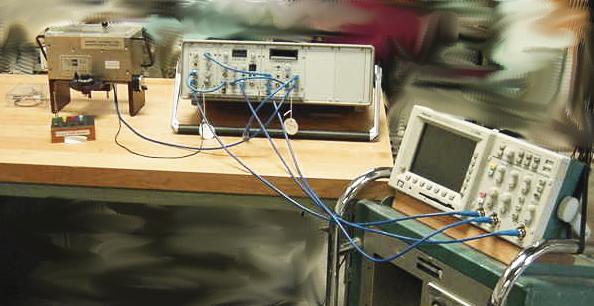Pulsed Nuclear Magnetic Resonance (Pulsed NMR)

In this experiment students are introduced to the modern NMR techniques underlying such applications as magnetic resonance imaging and mapping the structure of complicated organic molecules. Students learn how to put the sample in specific spin states, and then how to manipulate these spin states to accurately measure the longitudinal (spin-lattice) and transverse (spin- spin) relaxation times. In the process of mastering this "spin engineering", students learn how pulsed NMR techniques provide quantitative information about the spins and their environment that is not accessible using the simpler continuous wave NMR technique.
Experiment Information
- Write-up
- The TeachSpin PSA-1 manual: There are 5 sections, but you will probably only want to look at the first 3.
- Introduction (gives theoretical background.), pp. 1-13.
- The Instrument (describes details of the instrumentation), pp. 14-24.
- Getting Started (introductory exercises), pp. 25-34.
- Experiments (more advanced investigations.), pp. 35-36.
- Specifications (instrument specs.), pp. 38-39.
Discussion Questions
- Although the PSA-1 instrument is easy to use, there are a number of ways one can make a
mistake. The following list gives some of the more common ones. Describe how you would tell whether
each of the following mistakes was being made, based upon what you would see on the oscilloscope:
- The "Tuning" on the RF receiver is set too low (not the "Frequency").
- The cable between "RF out" and "Mixer in" is unplugged.
- In a T2 (pulse echo) measurement, the A width is set too high.
- In a T2 measurement, the delay time is set too long,
- In a T1 (inversion pulse) measurement, the repetition time is too short.
- The pulse echo method is supposed to give a good measurement of the true spin-spin relaxation (T2) time, even though the free induction decay follows the much shorter T2* time. Discuss why one should believe this, arguing from a reasonable model of molecular motion in a magnetic field gradient.
- The FID signal following a π/2 pulse is stronger than the signal following a 3π/2 pulse, which is stronger than the signal following a 5π/2 pulse. Why? Give as complete an answer as you can.
Background Information
- Pengra's VPython simulation of NMR
- http://www.magritek.com/support/videos/ Paul Callaghan (Univ. Wellington) video lectures for Magritek "Terranova MRI teaching system." The background information, especially the first two on the basic physics, and later ones on spin echo, T1 and T2. Their equipment is designed differently from ours, using the Earth's magnetic field for kilohertz resonance, but the basic physics is the same.
- Lecture notes on NMR (Pengra)
- Hahn, E. L., "Free nuclear induction", Physics Today, Nov. 1953, pp. 4-9.
- Hahn, E. L., "Spin echoes", Phys. Rev., 80, 580-594 (1950).
- Carr, H. Y., and E. M. Purcell, "Effects of diffusion on free precession in nuclear magnetic resonance experiments", Phys. Rev., 94, 630-638 (1954).
- Meiboom, S., and D. Gill, "Modified spin-echo method for measuring nuclear relaxation times", Rev. Sci. Inst., 29, 688-691 (1958).
- Simpson, J. H., and H. Y. Carr, "Diffusion and nuclear spin relaxation in water", Phys. Rev., 111, 1201-1202 (1958).
Other information is found on the page for Continuous NMR.